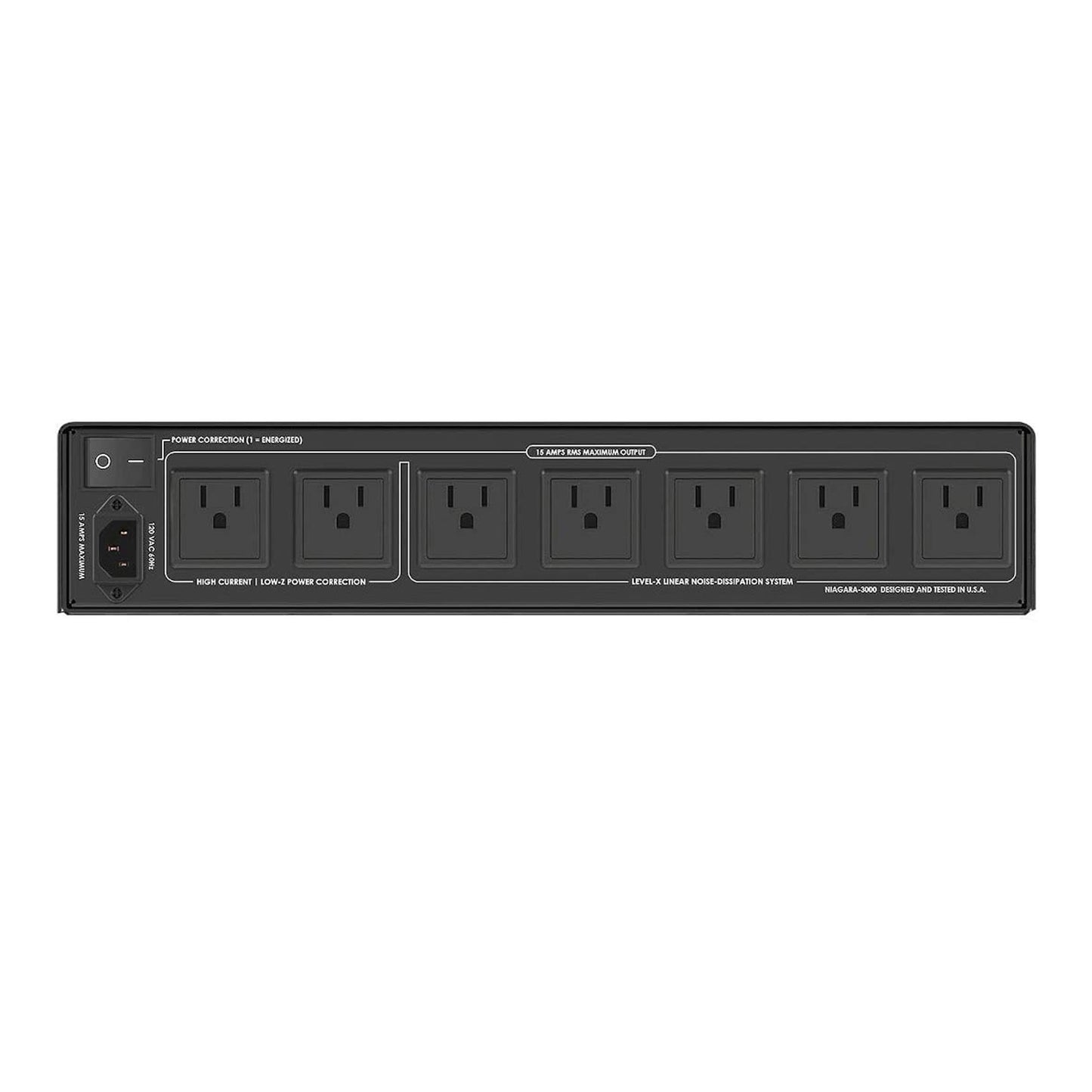AudioQuest Niagara 3000 Low-Z Power/Noise Dissipation System
AudioQuest Niagara 3000 Low-Z Power/Noise Dissipation System
Product questions? Found a lower price?
Let us know: 909.931.9686 or chat.
Couldn't load pickup availability
This item qualifies to earn HiFives. What's a HiFive?
View full details

AudioQuest Niagara 3000 Low-Z Power/Noise Dissipation System
PLEASE NOTE: The Niagara 3000 does not ship with a power cord! It takes a 15 A cable and we recommend at least the AudioQuest NRG-Z3, but the AudioQuest Monsoon or better would give you the biggest benefit.
Redefining the Science of Power Conditioning
“As with all good design, getting rid of the devil in AC power requires attention to every detail. Thanks, Garth!”
—William E. Low, Founder and CEO, AudioQuest
The science of AC power delivery is not a simple one; it demands focus, and the devil is in the details. In fact, the great increase in airborne and AC-line-transmitted radio signals, combined with overtaxed utility lines and the ever-increasing demands from high-definition audio/video components, has rendered our utilities’ AC power a somewhat antiquated technology.
Where Alternating Current (AC) is concerned, we’re relying on a century-old technology created for incandescent lights and electric motors—technology that was certainly never meant to power the sophisticated analog and digital circuits used in today’s premium audio/video systems. To properly accommodate the promise of today’s ever-increasing bandwidth and dynamic range, we must achieve extraordinarily low noise across a very wide range of frequencies.
Further, today’s power amplifiers are being taxed for instantaneous peak-current demand, even when they’re driven at modest volumes. Although we have seen a substantial increase in dynamics from much of our audio software, the loudspeakers we employ to reproduce them are often no more efficient than they were two to four decades ago. This places great demands on an amplifier’s power supply, as well as the source AC power supplying it.
Our systems’ sensitive components need better alternating current—a fact that has resulted in a host of AC power conditioning, isolation transformer, regeneration amplifier, and battery back-up system topologies. Through differential sample tests and spectrum analysis, it can be proven that up to a third of a high-resolution (low-level) audio signal can be lost, masked, or highly distorted by the vast levels of noise riding along the AC power lines that feed our components. This noise couples into the signal circuitry as current noise and through AC ground, permanently distorting and/or masking the source signal.
Given that the stakes are so high, all sincere attempts to solve this problem must be applauded.
Once the audio/video signal is gone, it’s gone forever…
For AudioQuest, honoring the source is never a matter of simply using premium “audiophile-grade parts” or relying on a proprietary technology—common approaches within our community. For years, we have all been witness to the same, seemingly endless audiophile debates: valves versus transistors; analog versus digital; can cables really make a difference?; and on and on. While we, too, can brag about our many unique technologies, we realize that true audio/video optimization is never a matter of any one secret or exotic circuit. When it comes to noise filtering for AC power, many approaches can yield meaningful results. However, these approaches may also impart ringing, current compression, and non-linear distortions that can render the cure worse than the disease!
Features
- Transient Power Correction: Provides over 55 A peak instantaneous current reservoir with reduced line impedance for current-starved power amplifiers, whether they incorporate linear or switching power supplies
- Ground Noise-Dissipation System: AudioQuest’s patented technology vastly reduces ground-borne noise without compromising safety or creating low-level ground loops
- Level-X Linear Noise-Dissipation Technology: Ensures the most consistent and widest bandwidth noise dissipation possible, without the inconsistent results that typify minimalist, multi-node resonant peaking found in many AC power conditioners
- NRG Series AC Power Inlets and Outlets: These inlets and outlets feature both high purity red copper and beryllium copper for superior conductivity, grip, and strength. These are then direct-plated with a thick layer of silver via a “hanging-silver” process, to ensure the lowest impedance at radio frequencies, enabling superior noise dissipation
Specifications
Surge Suppression: Non-sacrificial (nothing to damage with repeated 6000 V/3000 A input surge tests, which is the maximum that can survive through a building’s AC electrical panel)
Extreme Voltage Shutdown Voltage: 140 VAC (will activate the main high-current relay to open within less than 0.25 seconds; automatically resets once the incoming power is within a safe range)
Transverse-Mode Noise Dissipation: In excess of 24 dB from 3 kHz to 1 GHz, linearized for dynamic (rising) line impedance with frequency (source) and 10 to 50 Ohm load, system current dependent
Input Current Maximum Capacity: 15 A RMS (total)
Level-X Linear Noise-Dissipation System AC Power Outlet Banks: 2 isolated groups (outlets 3 through 5 and outlets 6 and 7)
Transient power correction: 55 A for 20-30 ms
Number of AC Outlets: 7 (2 High Current/Transient Power Correction; 5 Level-X Linear Noise Dissipation System Power)
Power Consumption: Typically, less than 0.25 A at 120 VAC input, or with the power correction switched to “off ”/“0” setting. (This is dependent on a reactive vector load. For more info, see “Operation and Continuous Use: Rear-Panel Power Correction Switch – Niagara 3000 current draw.”)
Dimensions: 17.5” W x 3.45” H x 15.2” D (2-RU rack-mounting ears are provided)
Weight: 24.9 lb


